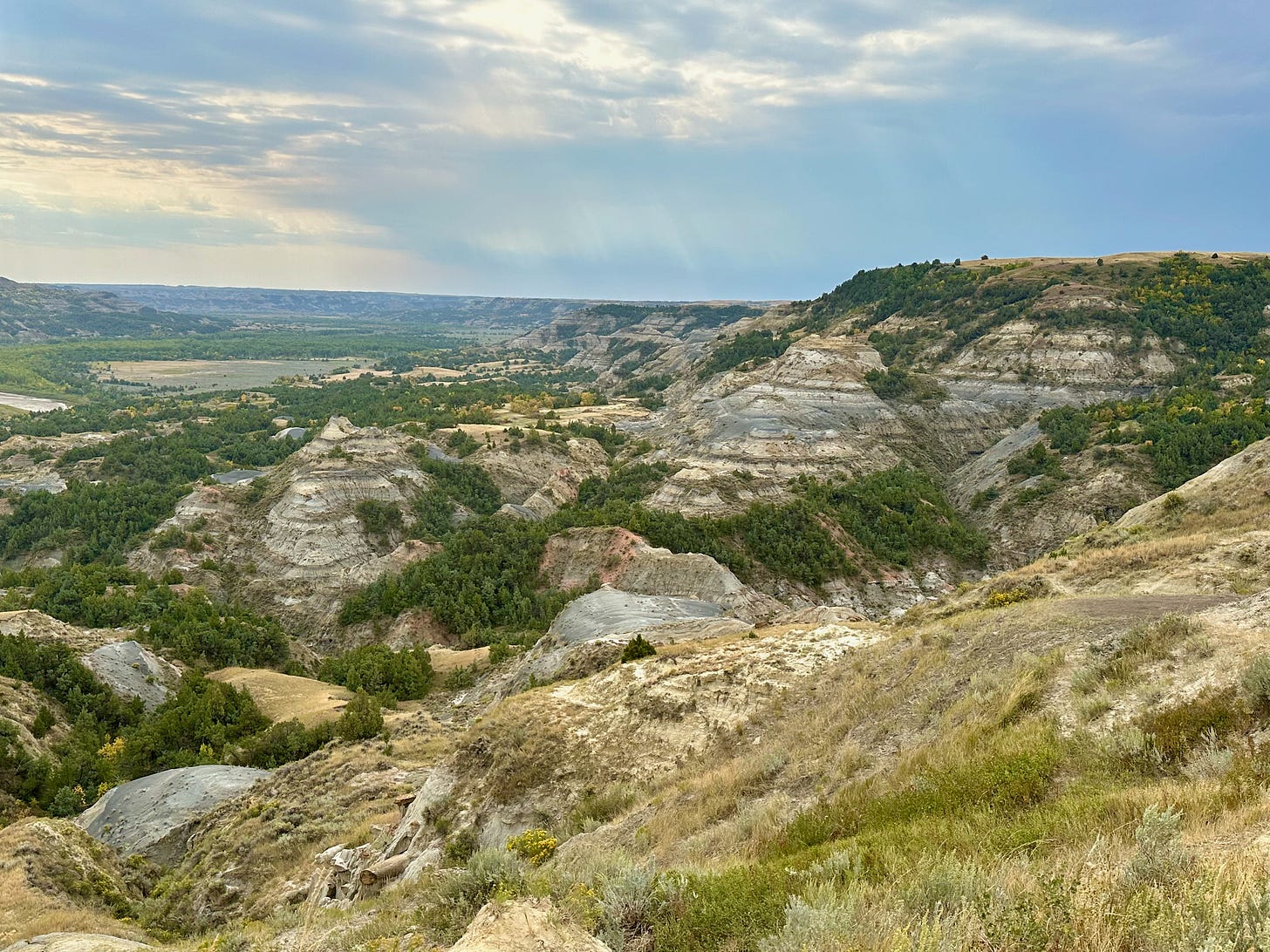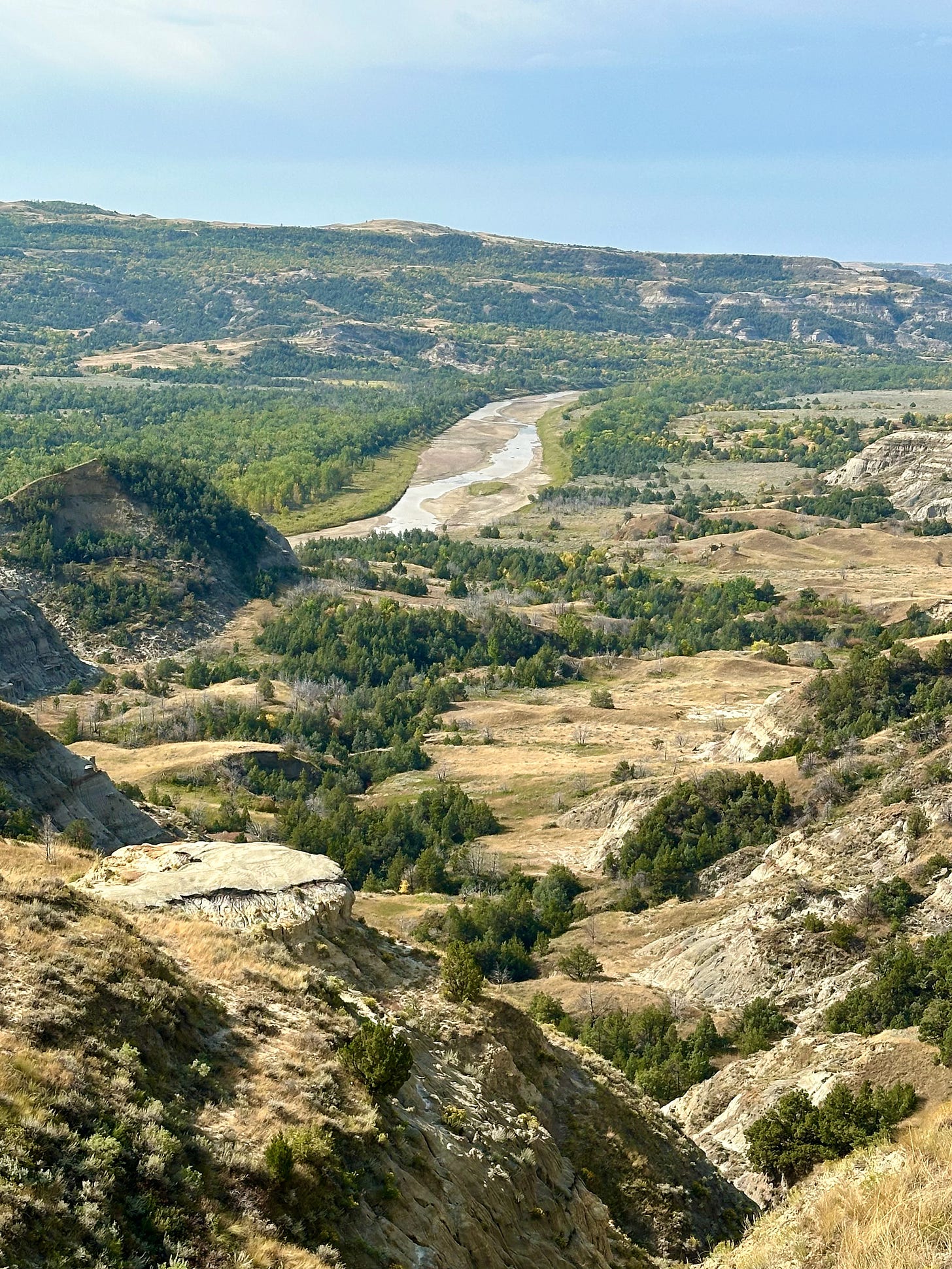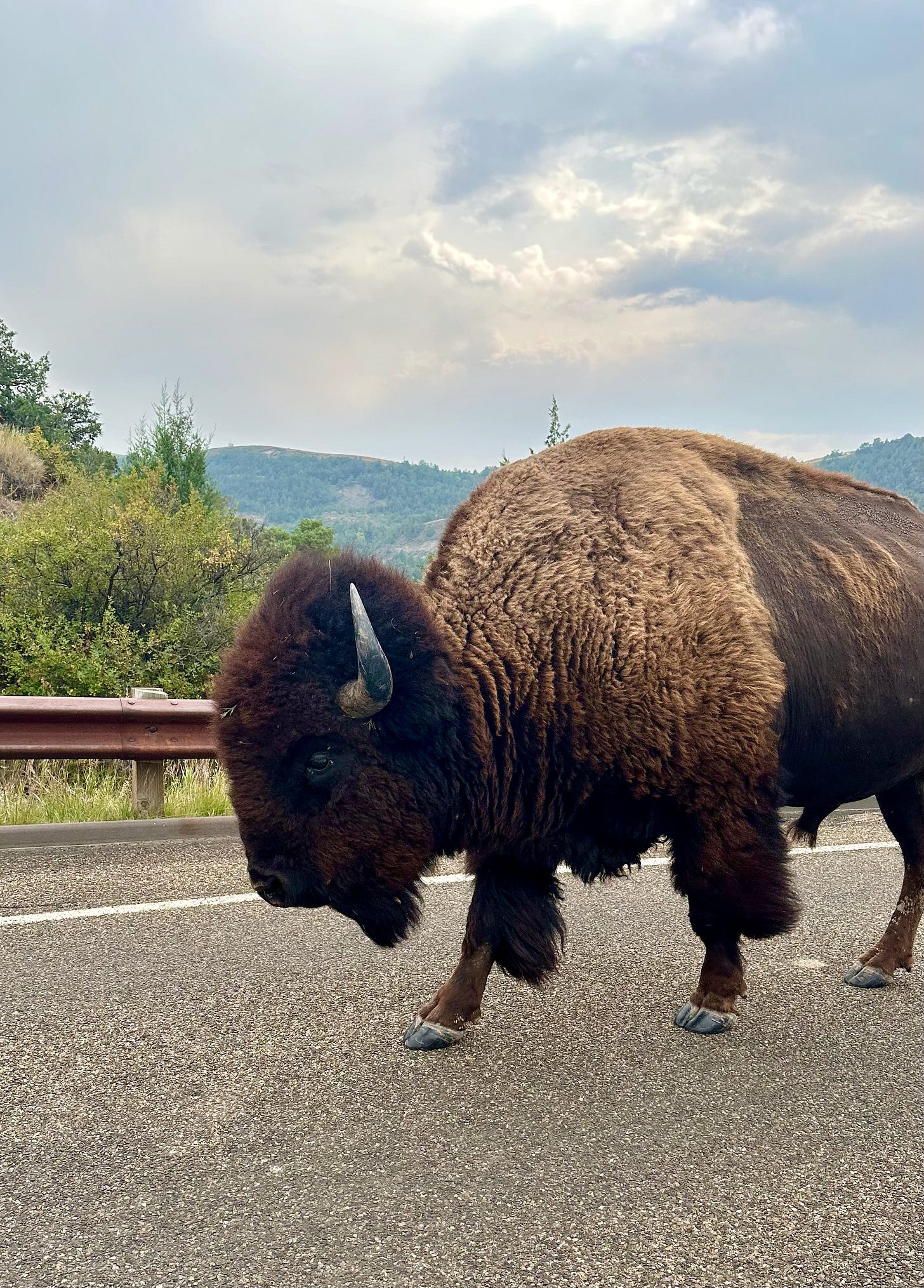Road Trip To The Boundary Waters (29)
Where Theodore Roosevelt Began His Journey to Manhood
When I set out for the Boundary Waters from California, there were two places I planned to visit on the return trip, Theodore Roosevelt National Park in western North Dakota and the Bighorn Mountains of eastern Wyoming. Getting back to the Bighorns in time--that is, before the snow and cold rendered hiking less attractive to me--was of particular concern to me from the outset. Just a few years before, I had arrived in late September, which was too late. There was already an inch of fresh snow in the higher elevations, where I planned to hike, the chill in the air compounded by high winds, was also uninviting.
In retrospect, I should have lingered longer in the U.P., to explore the Keweenaw Peninsula, among other places, and leave the Bighorns for another trip. Instead, though, I decided to make a beeline for the Bighorns, a visit to Theodore Roosevelt National Park, my only significant stop along the way. With an overnight stay in Fargo, it would take two days to get to T.R.N.P., with no side trips. Which dampened my mood, because side trips, often spontaneous, are for me the very essence of any worthwhile road trip.
Soon after I departed from Fargo, my mood worsened, as the sky became polluted with smoke from wildfires far to the west. The increase in wildfire smoke over the past two decades has become the bane of my outdoor existence. In August and September, it is almost impossible to escape the smoke at some of the places I hold most deer. But North Dakota? To affect the skies there, much of the west must be burning, California most certainly included. Disheartening in and of itself. But even more so when I contemplated driving the rest of the way home beneath the pall.
Having traveled perhaps 1500 miles the smoke was diluted but still concentrated enough to wreck any prospect of a crisp blue autumnal sky. My aversion to smoky skies partly stems from photographic concerns. And partly because of my experience fighting wildfires as a seasonal employee of the National Forest Service, working in smoke as claustrophobically dense as San Juaquin Valley tule fog in December. But mostly, wildfire smoke just depresses me as a vision of our apocalyptic future.
I was hoping for a storm front of some kind to wipe the crap from the air, and at one point about 150 miles east of TRNP it seemed my wishes might be granted. The air was stirring at least, and I thought I could distinguish something cloudlike amongst the pastel yellowed atmospheric background. Just my imagination though.
So I entered the park in a foul mood. My mood only worsened when I arrived at Cottonwood Campground. The last time I had camped there it met three of my four criteria for a great campground: No electricity, no flush toilets, and no potable water. The fourth, no people, would have been too much to ask for. But this time two more of my criteria were violated. Not only had potable water been installed but freshly sanitized bathrooms with flush toilets as well. Only the lack of electricity remained to recommend the Cottonwood Campground. I don’t want to deemphasize the importance of that factor. It eliminates about 75% of all campers and 99% of those giant RVs inhabited by campers who don’t actually enjoy camping.
Overall the campground had deteriorated for me. But as I was setting up camp the atmosphere above was changing. The front I had wished for seemed to be coming, the smoke incorporated clouds provided some interesting visual background. Interesting enough for my iPhone camera but not yet interesting enough for my DSLR.
Theodore Roosevelt National Park
TRNP is not at all a typical national park. It was not fully gazetted until 1978, though parts of the area were preserved in one way or another immediately following T.R.s death in 1919. I had explored the park on two previous occasions, once before it was officially a National Park. Partly because of its late designation and partly because it is more remote than most national parks in the lower 48, TRNP is one of the least visited national parks, a major attraction for me. It receives half as many visitors as Badlands National Park in South Dakota.
Like the Badlands National Park to the south, TRNP is considered a badlands environment. Badlands are highly eroded areas in sedimentary deposits, usually found in arid environments. Badlands are so called because they are bad for agriculture. What’s bad for agriculture though, is generally good for the natural flora and fauna.
But the badlands of south Dakota and the badlands of North Dakota differ in important ways. Most significant, the North Dakota badlands are much less arid, the vegetation lusher.
There are many more trees through TRNP than can be found in its South Dakota counterpart. And the bottomlands, on each side of the Little Missouri river are densely forested.
In mid-September many plants remained in flower. Moreover, while the South Dakota badlands have been almost exclusively formed by many temporary rivulets produced by occasional massive storms, the badlands of TRNP were largely eroded by a major river, the Little Missouri, which runs along the west side of both units on its way to meet its big brother to the northeast. Smaller scale erosion, such as you find in the south Dakota badlands also occurs, but the thicker vegetation mutes it considerably. It’s a badlands of a quite different flavor. The fauna, however, closely resembles that of the south Dakota badlands, among which are pronghorn, prairie dogs and bison.
(King of the road from driver’s seat. With smoky clouds)
The area preserved in TRNP is not extensive. Moreover, it is split into two units (North and South), separated by 70 miles. Most of the intervening area is designated National Grassland, preserving some continuity between the two units. The diminutive size of the national park lands largely stems, as always, from local resistance. Many ranchers were opposed to national park designation for any land in the area, as it would encroach on their grazing rights. (For some reason, cattle ranchers throughout the western U.S. believe they have inalienable rights of unfettered access to federal lands, no matter the ecological destruction cattle grazing causes. {And even though their ancestors were granted the land, gratis, by the federal government, at the expense of the Native Americans who had dwelled in the area for millennia.} And the government places few restrictions on the ranchers. This allows them to augment their herds beyond the number that their own private lands can support. It’s a particularly pernicious welfare program, but of course the beneficiaries don’t recognize it as such. Welfare to them is whatever government benefits the urban poor receive.) Partly because of the continuous squawking by local ranchers, both units have now been fully enclosed by fences, to keep the bison from roaming into the surrounding federal grassland, which the ranchers, through logic comprehensible only to them, consider their own private domain.
Most visitors first explore the South Unit, which is directly accessible from I-94 near the touristy town of Medora, which projects an old west vibe though it was founded as a railroad stop, and the arrival of trains throughout the west marked the transition from the real Old West to the Faux Old West. But it was still old west enough to attract Theodore Roosevelt.
T.R.
He arrived by train soon after the death of his first wife. T.R. mourned her in his own way, by shooting a bison, the first step in his masculinization program. T.R. was a sickly near-sighted child, who was evidently bullied. Like Charles Atlas, a century later, he sought to rectify the problem through vigorous physical exercise. Unlike Atlas, though, Roosevelt preferred to do his exercise outdoors, hiking and hunting. T.R. also sought to challenge himself courage-wise, which culminated in his leading the charge of army irregulars, called The Roughriders, up San Jaun Hill, Cuba, during the Spanish American War, a manufactured war that T.R. did much to instigate.
He eventually invested in a ranch in the North Dakota badlands. That project went belly up and Roosevelt lost a lot of money. But his affection for the land was undiminished. His former ranch property is now a (small) third unit located between the north and south units. I had seen it before, and the setting—the bottom of a valley carved by the Little Missouri River--was idyllic. But I chose to focus elsewhere this time.
I have always felt ambivalence toward T.R. On the one hand he had some noteworthy progressive inclinations and accomplishments. We could use his feisty antagonism toward outsized corporations today. If he were president now, Meta (Facebook), Alphabet (Google), Apple, Amazon and Microsoft would be under government siege. His anti-corruption campaigns while New York City Police Commissioner and as Governor of New York State were also laudable. And he was instrumental in the formation of what became the Department of Labor, as well as the Food and Drug Administrations. Roosevelt, despite his penchant for big game hunting, had a conservationist sensibility, creating and expanding the National Forest lands and what became the National Wildlife Refuge system.
On the other hand, his racist attitudes toward African Americans and Native Americans were deplorable. The famous quote that “the only good Indian is a dead Indian” only slightly mischaracterizes his view re the latter: “but I believe nine out of ten are, and I shouldn’t like to inquire too closely into the case of the tenth”. So it must be especially galling for Native Americans that his mug is on Mount Rushmore, on land stolen from the Sioux Reservation through a series of broken treaties.






